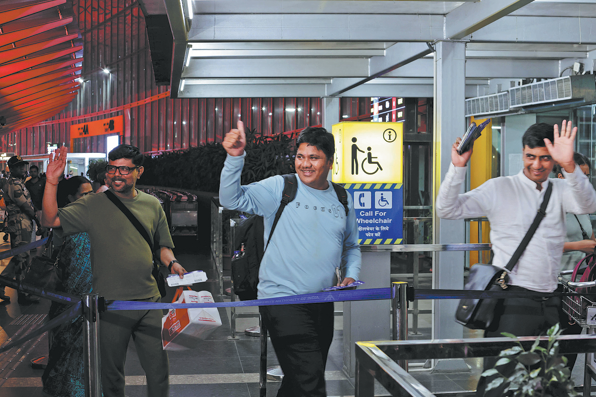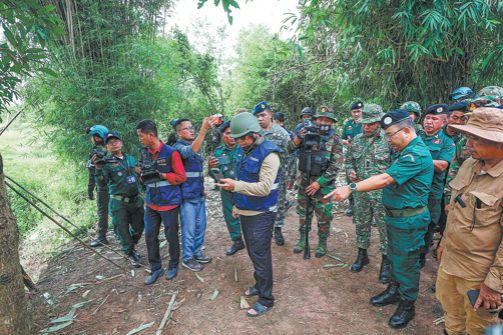Hurdles remain over next phase of Gaza truce
Issues such as Hamas' disarmament, Israeli pullout need solution: Analysts


One month after the ceasefire agreement went into effect, relative calm has returned to the Gaza Strip, but experts caution that advancing to the second phase of negotiations faces significant hurdles, while a prolonged deadlock risks reigniting conflict.
Hamas and Israel have maintained a fragile ceasefire in the Gaza Strip since Oct 10 after more than two years of fighting. The implementation of the first phase of the ceasefire agreement, focused on boosting humanitarian aid and the exchange of hostages and prisoners, has yielded tangible results.
Hamas has released 20 living hostages and the remains of 24 others, while Israel has handed over the bodies of approximately 300 Palestinians. Aid delivery has also improved significantly. Between the ceasefire's start and Nov 3, the UN and its partners have transported over 37,000 metric tons of humanitarian supplies into Gaza through reopened crossings.
Niu Xinchun, executive director of the China-Arab Research Institute at Ningxia University, noted that the first phase has been largely effective. "Hamas has released all surviving Israeli hostages. A steady, though limited, flow of humanitarian aid has been restored," he said. "The initial phase has basically achieved its intended goals, easing humanitarian suffering and de-escalating the intensity of the conflict."
Despite these gains, the truce remains precarious. Both sides have accused each other of violations, and sporadic skirmishes have continued. According to the Gaza health authorities, at least 245 Palestinians have been killed since the ceasefire began.
Shu Meng, an assistant professor at Shanghai International Studies University's Middle East Studies Institute, said that incidents like sporadic attacks are eroding the foundation for future talks and complicating efforts to move into the second phase.
According to the US-proposed 20-point plan to end the conflict in Gaza, the second phase of negotiations, involving key issues like the disarmament of Hamas and full Israeli withdrawal, would begin after the completion of the hostage and remains exchange. Yet, experts pointed out that this is where the real challenge begins.
Israeli Prime Minister Benjamin Netanyahu vowed on Nov 2 to disarm Hamas and demilitarize the Gaza Strip, saying his government would keep targeting the remaining militant cells despite the ceasefire. He met earlier this week with Jared Kushner, US President Donald Trump's son-in-law, to discuss the progress and future of the ceasefire, but no details of the second phase have been worked out.
Shu highlighted a lack of willingness to negotiate, irreconcilable internal divisions, and fundamental disagreements on core issues as key challenges facing the second phase.
Irreconcilable divisions
"Mutual suspicion is diminishing the willingness of both sides to advance subsequent negotiations, with Israel accusing Hamas of using the truce to rearm, and Hamas doubting Israel's commitment to lasting peace," she explained. "Furthermore, both sides face internal pressures. In Israel, right-wing and hard-line factions continue to disrupt consensus-building. Hamas also faces internal rifts, hindering constructive engagement."
"Crucially, neither side is willing to compromise on core demands. Israel sees the next phase as vital to its security, while Hamas views concessions as an existential threat. This presents the biggest hurdle to progress," she said.
Niu noted the issue of Hamas disarmament as a central stumbling block. "The second phase requires Hamas' disarmament, establishment of a transitional government in Gaza, and full Israeli withdrawal. But the first step of disarming Hamas is hard to resolve."
He attributed the deadlock to a deeper flaw in the US' 20-point plan, arguing it fails to outline a credible path toward the two-state solution.
"Without that political horizon, and with Palestinians largely excluded from the proposed transitional governance structure, disarming Hamas becomes an intractable problem."
Shu echoed this concern, noting that the 20-point plan, by making Hamas' disarmament and exit from governance a core precondition, "severely overlooks Hamas' demands".
"Armed strength is the foundation of Hamas' existence, and governance rights represent its crucial future interests in Gaza. They must retain at least one of the two. The plan puts Hamas in a lose-lose situation, severely dampening its willingness to negotiate and sowing hidden dangers for future consultations," she said.
Experts said if the second-phase talks remain deadlocked, the current truce will prove only a temporary respite. Eroding trust, combined with sporadic clashes or border incidents, could quickly unravel the ceasefire and trigger a renewed cycle of military confrontation, they warned.
Xinhua and agencies contributed to this story.

































